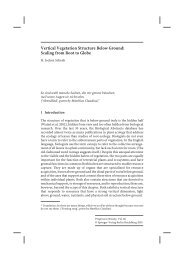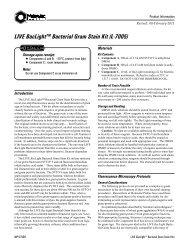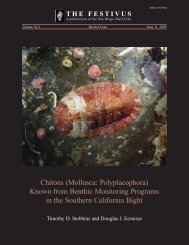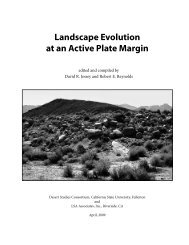2010 Overboard in the Mojave - Biological Science - California State ...
2010 Overboard in the Mojave - Biological Science - California State ...
2010 Overboard in the Mojave - Biological Science - California State ...
You also want an ePaper? Increase the reach of your titles
YUMPU automatically turns print PDFs into web optimized ePapers that Google loves.
9.7 (3.8) Cont<strong>in</strong>ue past <strong>the</strong> Bas<strong>in</strong><br />
Road <strong>in</strong>terchange. East Cronese<br />
playa, visible to <strong>the</strong> north, is fed<br />
by <strong>the</strong> <strong>Mojave</strong> River dur<strong>in</strong>g floods.<br />
It has an extensive record of past<br />
lakes and human occupations<br />
(Schneider, 1989: Warren and<br />
Schneider, 2000). A recent paper<br />
(Miller and o<strong>the</strong>rs, this volume)<br />
demonstrates late Holocene lakes<br />
present dur<strong>in</strong>g <strong>the</strong> Little Ice Age<br />
(~ AD 1650) and Medieval Warm<br />
Period (~AD 1290).<br />
17.3 (7.6) Pass through faulted<br />
Miocene sediments <strong>in</strong> road cut.<br />
View west <strong>in</strong>to Afton Bas<strong>in</strong> which<br />
was filled by Lake Manix <strong>in</strong> late Pleistocene time.<br />
18.3 (1.0) Exit I-15 at Afton Road.<br />
18.6 (0.3) Stop at Afton Road, TURN RIGHT (north).<br />
18.8 (0.5) PARK north of frontage road, on north side of<br />
off ramp.<br />
STOP Q- 1—Afton Barrier Beach. Cuts along <strong>the</strong><br />
freeway and <strong>in</strong> dra<strong>in</strong>age channels show that lagoonal deposits<br />
capped by weak soils are overla<strong>in</strong> by beach gravels,<br />
illustrat<strong>in</strong>g multiple lake occupations at this elevation.<br />
Lake Manix reached highstands at or just below 543 masl<br />
(1781 ft) at least three times dur<strong>in</strong>g <strong>the</strong> late Pleistocene,<br />
as suggested by Meek (1990, 2000). Highstands at this<br />
elevation are marked by well-preserved constructional<br />
beach barriers. Most such barriers are flat-topped with<br />
slop<strong>in</strong>g, gently rilled flanks. Retrace and PROCEED<br />
WEST along freeway frontage road.<br />
19.3 (0.5) STOP Q-2—Stromatolites. PARK. Cuts<br />
along <strong>the</strong> road show breaks <strong>in</strong> lake deposits, one prom<strong>in</strong>ently<br />
decorated by a row of stromatolite-capped pebbles,<br />
<strong>in</strong>dicat<strong>in</strong>g precipitation of calcium carbonate <strong>in</strong> clear,<br />
shallow, sun-lit lake water. CONTINUE SOUTHWEST<br />
on paved highway frontage road.<br />
20.1 (0.8) Pavement turns sharply right.<br />
20.2 (0.1) End of pavement.<br />
20.3 (0.1) TURN LEFT on pipel<strong>in</strong>e road and BEAR<br />
RIGHT (north).<br />
20.5 (0.2) PARK <strong>in</strong> quarry. Caution! Do not enter <strong>the</strong><br />
deep gully at <strong>the</strong> wash.<br />
STOP Q-3—Dunn Wash Gravel Quarry. “Dunn” wash<br />
exhibits lake expression <strong>in</strong> alluvial fan sediments (GPS<br />
coord<strong>in</strong>ates are 551615 E, 3880169 N, Reheis and o<strong>the</strong>rs,<br />
r. e. reynolds and d. m. mller<br />
Stop Q-3. Medial distal fan deposits complexly <strong>in</strong>terf<strong>in</strong>ger with lacustr<strong>in</strong>e sands and<br />
muds. M. Reheis photo.<br />
2007). The follow<strong>in</strong>g is summarized from <strong>the</strong> report <strong>in</strong><br />
Reheis and Redw<strong>in</strong>e (2008; Figs. 2 and 4), which conta<strong>in</strong>s<br />
detailed description and measured sections.<br />
At <strong>the</strong> Dunn Wash sites, at least four lake fluctuations<br />
are recorded. Dunn Wash was an active dra<strong>in</strong>age dur<strong>in</strong>g<br />
<strong>the</strong>se fluctuations, and <strong>the</strong>refore lacustr<strong>in</strong>e and alluvial<br />
sediments are <strong>in</strong>terbedded. These two depositional<br />
environments are very difficult to dist<strong>in</strong>guish <strong>in</strong> places<br />
where alluvial gravel was only slightly reworked dur<strong>in</strong>g a<br />
subsequent lake-level rise.<br />
The oldest lake unit (unit 1 <strong>in</strong> section M05-19, fig. 4 of<br />
Reheis and Redw<strong>in</strong>e, 2008) has basal lacustr<strong>in</strong>e gravel<br />
with thick tufa coats on clasts, overla<strong>in</strong> by green mud,<br />
silt, and sand that coarsens and th<strong>in</strong>s shoreward. The<br />
tufa-coated gravel persists to an altitude of at least 539<br />
masl. This unit is overla<strong>in</strong> by alluvial gravel of unit 2 and a<br />
buried soil with a Btk horizon. The buried soil is overla<strong>in</strong><br />
by three packages of beach gravel and sand (units 3, 4, and<br />
5) that rise and th<strong>in</strong> shoreward, typically with tufa-coated<br />
clasts at <strong>the</strong> base of each package and separated by weak<br />
soils or alluvial units. Lake units 4 and 5 can be traced<br />
to an altitude of about 543 masl. Anodonta shells near<br />
<strong>the</strong> base of unit 1 yielded a f<strong>in</strong>ite but m<strong>in</strong>imum-limit<strong>in</strong>g<br />
age of 49,800±2,000 14C yr B.P. (table 1 of Reheis and<br />
Redw<strong>in</strong>e, 2008). A s<strong>in</strong>gle prelim<strong>in</strong>ary U-series age on <strong>the</strong><br />
basal tufa is 71±25 ka ( J. Paces, U.S. Geological Survey,<br />
written commun. to Miller, 2007). Lake unit 3 is only<br />
locally preserved and may represent a m<strong>in</strong>or fluctuation.<br />
Anodonta shells with<strong>in</strong> unit 4 below a weak buried soil,<br />
yielded ages of 34,680 ± 260 and 31,900 ± 200 14C yr<br />
B.P. At two o<strong>the</strong>r sites <strong>the</strong> uppermost unit 5 conta<strong>in</strong>ed<br />
Anodonta shells that yielded ages of 25,420 ± 120 and<br />
26,030±100 14C yr B.P.<br />
The gravels here are generally similar to alluvial fan<br />
gravels, but <strong>the</strong> presence of Anodonta and lateral trac<strong>in</strong>g<br />
8 <strong>2010</strong> Desert Symposium
















